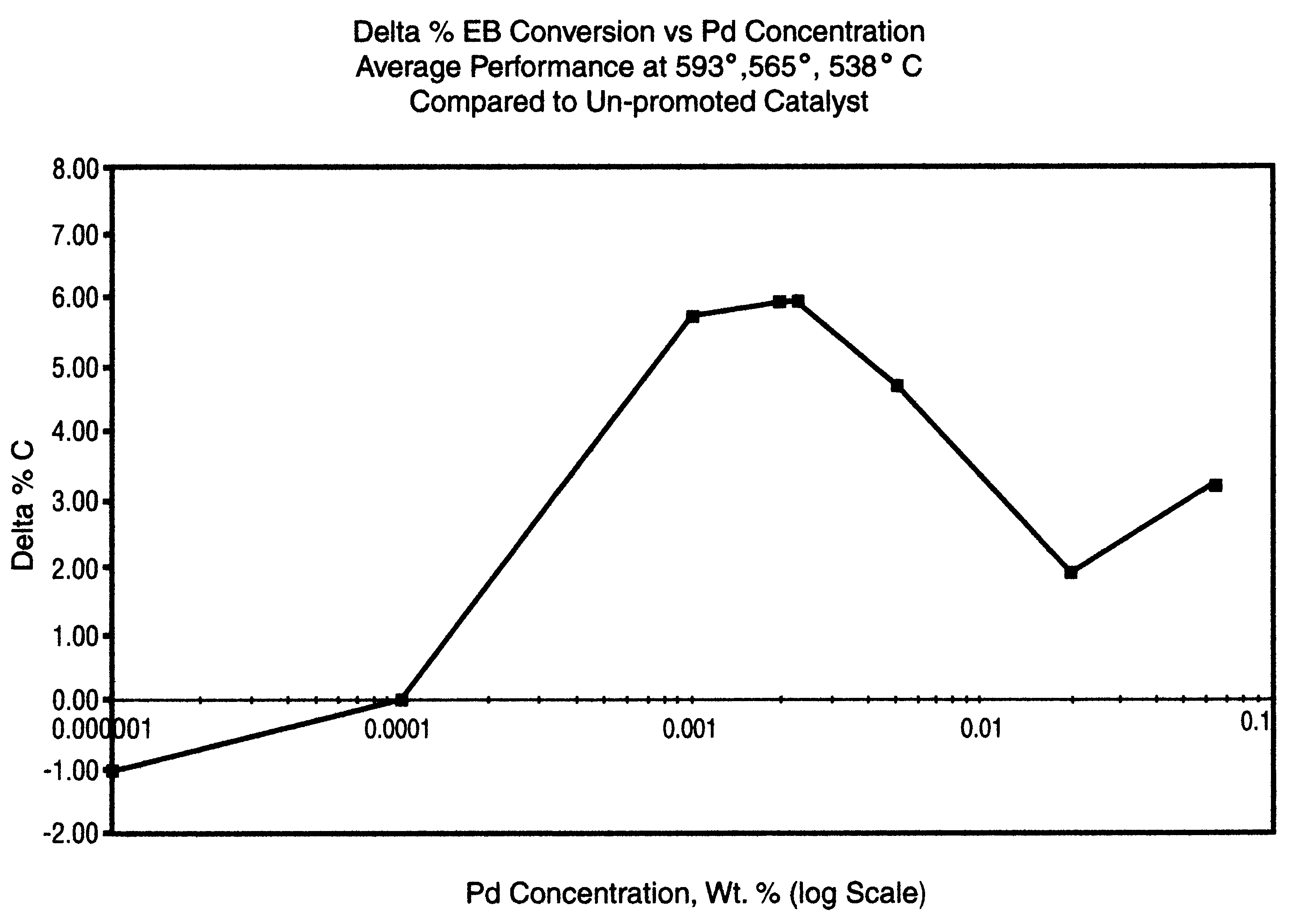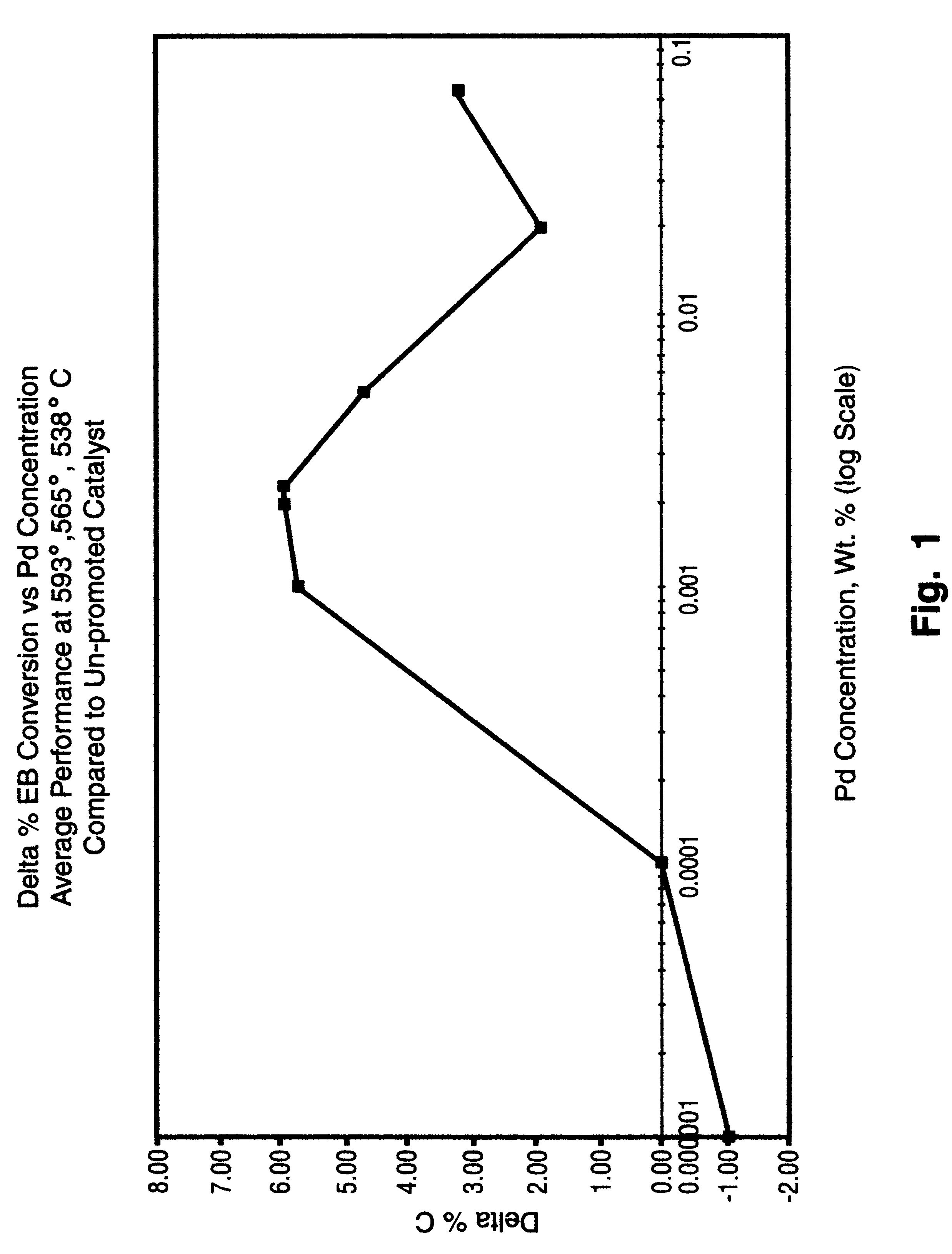Dehydrogenation catalysts
a technology of catalysts and catalysts, applied in the field of dehydrogenation catalysts, can solve the problems of undesirable by-products and inability to easily recycle toluene, and achieve the effects of high activity and selectivity, high activity and high selectivity
- Summary
- Abstract
- Description
- Claims
- Application Information
AI Technical Summary
Benefits of technology
Problems solved by technology
Method used
Image
Examples
example 2
The catalyst of Example 2 was prepared according to the procedure of Comparative Example 1, except that a palladium nitrate solution sufficient to produce a concentration of 0.072% Pd in the final catalyst was added to the water used to prepare the extrudable paste.
The catalysts of Comparative Example 1 and Example 2 were tested for ethylbenzene dehydrogenation performance in an externally heated tubular reactor of 1" internal diameter. A vaporized, preheated mixture of steam and ethylbenzene (with a molar ratio of about 12 / 1) was introduced to the catalyst at controlled throughput and pressure (LHSV=1 and pressure=1 atm.) over a range of temperature from 540.degree. C. to 570.degree. C. Dehydrogenated product exiting the reactor was collected and analyzed to determine conversion (% C) of ethylbenzene and selectivity (%S) to styrene. Table I shows the effect on performance of the catalyst prepared according to the invention.
TABLE I Comparative Catalyst Example 1 Example 2 Palladium ...
examples 4 and 5
The catalysts of Examples 4 and 5 were prepared according to the procedure for the catalyst of Comparative Example 3 except that palladium nitrate solution, Example 4, or dinitrodiamine platinum solution, Example 5, sufficient to produce a concentration of 200 ppm palladium or 368 ppm platinum in the respective calcined catalysts, was added to the water used to prepare the extrudable paste for pelletizing the catalysts.
The catalysts of Comparative Example 3 and Examples 4 and 5 were granulated (to a size of 0.85 to 1.18 mm) and evaluated for ethylbenzene dehydrogenation performance in a differential type reactor (steam / oil=12 molar, p=1 atm., catalyst weight / feed rate=14.7 times (g. cat..times.hr..div.mol). Dehydrogenation performance data are shown in Table II along with the indicated concentration of Pd or Pt. As in Comparative Example 1, catalyst performance was determined by analysis of the dehydrogenated product exiting the reactor.
TABLE II Comparative Example 3 Example 4 Examp...
examples 7 and 8
The catalysts of Examples 7 and 8 were prepared according to the procedure for the catalyst of Comparative Example 6 except that palladium nitrate solution, Example 7, or dinitrodiamine platinum solution, Example 8, sufficient to produce a concentration of 200 ppm palladium or 368 ppm platinum in the respective calcined catalysts, was added to the water used to prepare the extrudable paste for pelletizing the catalysts.
The catalysts of Comparative Example 6 and Examples 7 and 8 were granulated (to a size of 0.85 to 1.18 mm) and evaluated for ethylbenzene dehydrogenation performance in the manner described in Example 3. Dehydrogenation performance data are shown in Table III along with the indicated concentration of Pd or Pt.
TABLE III Comparative Example 6 Example 7 Example 8 Promoter none Pd Pt Promoter Concentration wt. % -- 0.0200 0.0368 D. P.* % C % S % C % S % C % S 600.degree. C. 30.18 98.55 43.04 97.87 37.12 98.58 585.degree. C. 21.10 98.89 34.60 98.43 28.79 98.95 570.degree. ...
PUM
| Property | Measurement | Unit |
|---|---|---|
| Fraction | aaaaa | aaaaa |
| Fraction | aaaaa | aaaaa |
| Fraction | aaaaa | aaaaa |
Abstract
Description
Claims
Application Information
 Login to View More
Login to View More - R&D
- Intellectual Property
- Life Sciences
- Materials
- Tech Scout
- Unparalleled Data Quality
- Higher Quality Content
- 60% Fewer Hallucinations
Browse by: Latest US Patents, China's latest patents, Technical Efficacy Thesaurus, Application Domain, Technology Topic, Popular Technical Reports.
© 2025 PatSnap. All rights reserved.Legal|Privacy policy|Modern Slavery Act Transparency Statement|Sitemap|About US| Contact US: help@patsnap.com


